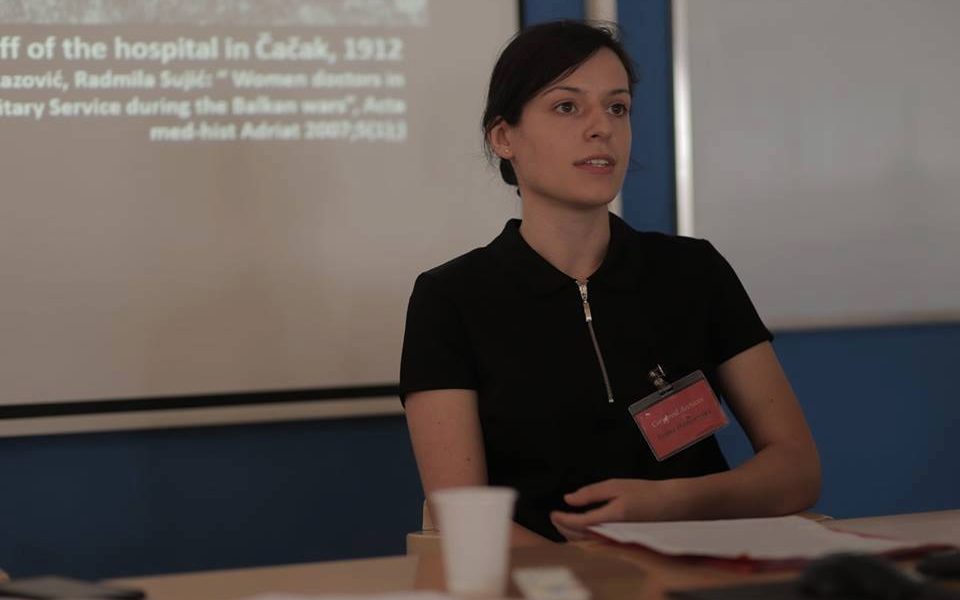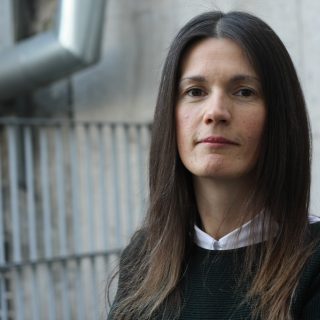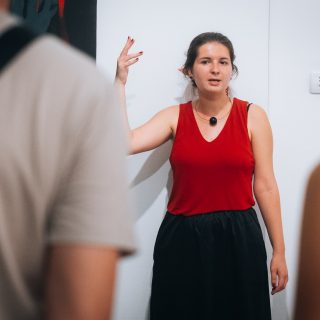Ivana Hadzievska, MSc
I vividly remember my visit to the Museum of Technology and Maritime Affairs in Malmö (Teknikens och Sjöfartens Hus) in 2017. Soon after the visit, sorting out the impressions, I realized that the authors of the setting had a great idea on how to deliver their concept, as well as the educational and didactic message at the very entrance and thus “welcome” the visitor. Namely, at the very entrance of the exhibition, after passing the lobby, and opening the simple minimalist door from the outside, the huge gallery space opens before you – actually the first level of the opulent exhibition of machines, cars, ships, submarines… representations of the impact of the industrial revolution in the history of Sweden. But, in the left corner, right next to the front door, there was an element that could only be seen out of the corner of the eye, while the visitors’ view was captured by the rich setting of large objects set frontally from the viewer. There, in the corner, stood a white plaster sculpture that was a simulation of the famous ancient Greek Discobolos (disc thrower) – a single element that divided and bounced off the entire mechanized, almost steam-punk, technological setting. After completing my tour, and digesting the exhibition’s perfectly timed narrative, the subtle presence of the aesthetically perfect human body in athletic formation, placed at the beginning of the exhibition, began to become clear to me: this element was not there to induce aesthetic bliss, but much more to be a warning: the cautionary tale of European/Italian futurism, the danger of ideologies following the processes of technological modernization, the progressiveness and cruelty of the industrial revolution, machoism, fascism and similar ideologies according to which the man-machine should destroy everything that deviates from his model. When I managed to decipher that message, I was delighted by the authors’ concept, by the way the museum formulated its message; and definitely, for me as an economic historian of the 20th century, this setting is still one of the best I have visited, although my profession requires me to spend time often in various institutions and “houses” of cultural memory.
In fact, when we want to analyse the ways in which museums, or other “houses” of (re)presentation of cultural memory, “package” their state and national cultural products, or the ways in which they successfully (or economically cunningly) connect their basic thematic narrative with an educational and didactic aspect, and (sometimes) simultaneously with the attempt to attract tourists, it is good to know from an awareness perspective, that museums are always ideological and political institutions, which in many ways influence the official formation of ideas about the world and the relations in them. This fact can be positioned institutionally and avant-gardly, towards the creation of epistemological and methodologically based concepts and narratives, with an enlightening approach towards the visitors; or institutionally and retrospectively, where the cultural messages, consciously or unconsciously, mobilize certain identity entities or groups of the population, taking away the universality.
Let me return to the practical example from the beginning of the text and add one more – a local example. Inspired by the Museum of Technology in Malmö, I began to think about the great and untapped potential for a similar museum-representation of the industrial past in the Macedonian context: artefacts and objects, curated through a contemporary discursive framework, that would show how modern working class developed on a post-Ottoman soil – isn’t that a great idea for – both a museological narrative step (due to the connection of Macedonian local history with the trans-national and a universal history of the 20th century) and a cultural transformation, thus bringing it in line with the final protection of old buildings significant to the local history.[1]
But such “ideal” thoughts were often interrupted by another museum anecdote, this time from Skopje. During my studies, in 2014, within the framework of practical teaching, I had the opportunity to examine in more detail the setting of the newest Macedonian museum, which at that time was called “The Museum of the Macedonian Struggle for Statehood and Independence – Museum of the Internal Macedonian Revolutionary Organization and Museum of Victims of the Communist Regime”. Numerous professional and aesthetic analyses can be found about this museum, especially in the context of the national project “Skopje 2014”.[2] However, since this kind of analysis is not the subject of my text, I would just summarize that it is a museum of “dark atmosphere”, whose narrative orientation is towards the mobilization of national identity compositions, through the use of highly affective visual tools. This means that the presentation of national sacrifice dominates, but at the same time, the historical superiority of the nation is brought to the forefront.
One part of the setting made a particular impression on me. The main stairs in the interior, centrally positioned along the formal hall, lead to the balcony-derived level (to which you actually exit after the end of the tour, i.e. at the exit of the exhibition)[3] where the wax figures of several historical personalities were placed, including Vladimir Lenin, Joseph Vissarionovich Stalin, Adolf Hitler, Benito Mussolini, as well as, quite unexpectedly in this sequence, but perhaps in line with the “dark atmosphere” of the museum, a statue of the Balkan psychic Baba Vangja. For the figures, for their mood in space, as well as for the narrative cohesion of their placement next to each other, there was no available explanation (panels or similar directions), nor a clarification of the logical sequence of their arrangement. According to the practice found at that time, although without any intention of generalizing the situation, the guides did not pay much attention with explanations about these figures (on the balcony), but simply explained them as “persons who marked the 20th century”, by simply stating their names.
But, what was particularly interesting to me was the very presence of Baba Vangja among the historical figures who marked the history of the 20th century. One possible message is the association of history as an abstract and speculative point and phenomenon (History with a capital H), which lies beyond the rationality of the scientific understanding of historical processes (which a museum based on sources and methodology should promote). Another possible message is that these historical figures and all their historical and symbolic capital, from regional and European history (Hitler, Stalin, Vancho Mihailov…) are a fatal product of “divine providence”, not economic, political, social and other factors, which exist, but are themselves subordinate to the “higher forces”. Therefore, the very science of history (as an academic field, but also as a civilizational phenomenon) is null, because there is always another, “true”, “authentic”, “hidden”, “suppressed” History, which can only be “made known” to those who are themselves “pure” (primarily nationally) and (identityally) unblemished (from The West, the neighbours, the traitors, the conspirators…). So set, the (non)epistemological position of this museum concept is actually legitimate and it seems to say: “Official (western-hegemonic or communist-anational) science hides and steals something from us, so we are “real” scientists here, because we have the necessary “sensitivity” to detect the “real” truth, as Baba Vangja has the power of prediction”.
The last, local, example did not inspire me like the Swedish example, but perhaps more importantly – it directed me to thinking about the practical problems of cultural memory institutions. And they are always connected to the complex system of discursive exchange, which connects expert institutional practitioners, academic critics, stakeholders for the maintenance of memorial sites, the importance of cooperation and the openness of roads between civil society organizations, activists in the field of cultural initiatives and institutions, working conditions, the political influences, but also the ability of the personnel to conceptualize the future of the institutions (digitalization, local participation, enabling a warm atmosphere, i.e. facilitated the use of institutional space for various cultural events for age groups from 7 to 77 years old, etc.). Perhaps the local anecdotes are good for drawing the conclusion that the (non)existence of emancipating and educated institutional narratives on the representation of cultural memory depend solely on the political and sociological position of culture, on the executional level in the chain of establishing and implementing policies.
However, I feel that it is necessary for this text format to end on an inspirational note. Even more if I can also confirm the conclusion from the previous paragraph. The Museum of the Macedonian Struggle in the period 2018-2021 experienced a greater transformation, which is mostly noticeable in two aspects: critical interpretation of its own setting; and opening the museum space to a variety of events related to civic cultural initiatives. During this period, the name was also changed, from the long title, to the shorter “Museum of the Macedonian Struggle”. In that regard, I currently have no information about the presence of the wax figure of Baba Vangja in the interior of the museum and clarifications about her presence in the narrative framework. In fact, the purpose of that transformation was political: the new government in the state after 2017 began to establish a new national historical narrative, which aimed at denying and supplanting the previous ethno-national model (implemented by the previous state government), and rapidly establishing the civil pro-Western model, which was also not free from controversial events. Without going into the details of this process,[4] perhaps it is more interesting to dwell on the museum’s strategies for confronting “its own past”. In the new narrative conception, one successful example of self-criticism is the addition of museum contents with topics, occasional exhibitions and scientific and popular activities in the field of women’s history from the Macedonian past.[5] While in relation to the processes of opening the museum space to different groups (citizens, outside the initial target group – the ethnic Orthodox Macedonians), I consider one of the most successful examples in this direction to be the performance of a memorial event dedicated to the Roma Holocaust, in organization of a civil organization of the Roma people from Skopje, in 2022.[6]
In the end, I would add that in order to successfully solve the “practical problems” I am talking about in this text, it would be very useful to return to the concept of “social worker” or “scientist”. It was a positive cultural experience from the socialist period and in our country. Under that concept, it is understood that these workers, from the sphere of science or culture, are not just academic or institutional scientists, but their work is directed towards the outside, the outside of their office work, with activity in the community, in the press, in the public sphere. Of course, that process depends on several factors: the media, education, cultural policies…which are new “practical problems”, the worthy solution which still requires a dose of avant-garde among actors and politicians, not at all conservatism… no matter how difficult it is and no matter how dangerous the reaction, armed with strong post-truth-era tools might be.
Biographical note of the author:
Ivana Hadzievska is a historian and independent researcher. She received her master’s degree (2021) in the field of economic history (“The human condition of industrial workers in Vardar Macedonia 1918-1941”, 2021). Her research interest is in the field of philosophy of history and politics of memory.
[1]On 23 January 2022, under still unclear circumstances, the building of the old mill in Bitola burned down. It was a 120-year-old building, built by the Ottoman industrialist Ismail Beg, under the name “Dragor”. This building with typical and rarely preserved Ottoman architecture from the end of the 19th century, housed the socialist grain giant “Zhito Bitola” until the collapse of this factory in the early 2000s. Considering the history of the building, it represented the economic and social history of the city for two centuries. The fate of several such historical buildings in Macedonia is similar.
[2]The “Skopje 2014” project was implemented in Macedonia by the democratic-Christian and conservative VMRO-DPMNE party in power, under the leadership of the then Prime Minister Nikola Gruevski, in the period 2008-2017
[3]According to a newspaper article, the scene is described as follows: “The main staircase for visitors leads to the second floor, to wax figures of a range of world historical figures, spanning the 19th and 20th centuries. Here you will see Abdul Ahmed II and the first Russian Prime Minister Vladimir Lenin. Then, the founder of the Albanian Orthodox Church Fan Noli, the Serbian socialist politician, journalist and professor Kosta Novaković, one can also notice the figure of Georgi Dimitrov, Woodrow Wilson, Marcos Vafeiadis, all the way to Baba Vangja, Tsar Boris II and Winston Churchill. If someone catches sight of Joseph Stalin’s moustache and pipe, someone else will surely think that Benito Mussolini and Adolf Hitler are fighting with their arms raised. In fact, they are giving each other a Nazi salute.” Bojan Shashevski, “Report: Two historical museums to the left of Vardar – two museum worlds, extravaganza vs. erosion!”, MKD.mk, 29 July 2016. Available online: https://www.mkd.mk/makedonija/politika/dva-istoriski-muzeja-levo-od-vardar-dva-muzejski-sveta-raskosh-nasproti-erozija#1
[4]Ivana Hadzievska. 2020. “Cultural and Religious Lines of Separation of Ethnic Macedonians:
Symbolic divisions in two contemporary projects of nation construction”, in Us vs. Others: Symbolic Divisions in North Macedonia, ed. Jovan Bliznakovski and Petar Todorov, p. 21-43. Skopje: Center for Research on Nationalism and Culture. Available online: https://cinikskopje.files.wordpress.com/2020/11/e-d0bad0bdd0b8d0b3d0b0-d09dd0b8d0b5-d0bdd0b0d181d0bfd180d0bed182d0b8-d094d180d183d0b3d0b8d182d0b5-d0a6d098d09dda092d.pdf
[5]Examples: “The woman fighter for freedom and the Macedonian state”. Exhibition about Macedonian heroines, prominent women during the National Liberation Struggle (on the occasion of the holiday for the Macedonian National Liberation Uprising, 11 October 2022); The multidimensional project “Project Several Shades of Women’s Stories”, which consists of research and publication of educational videos about prominent women in Macedonian history, can be viewed on the museum’s official YouTube channel: https://www.youtube.com/channel/UCn6q7IJheJyFRhePlkFmyhg
[6]RadioMOF.mk “Performance of six dramatic dialogues “Nazi remnants” at the museum of the Macedonian struggle”, 23 August 2022. Available online: https://www.radiomof.mk/izvedba-na-shest-dramski-monolozi-nacistichki-ostatoci-vo-muzejot-na-makedonskata-borba/




